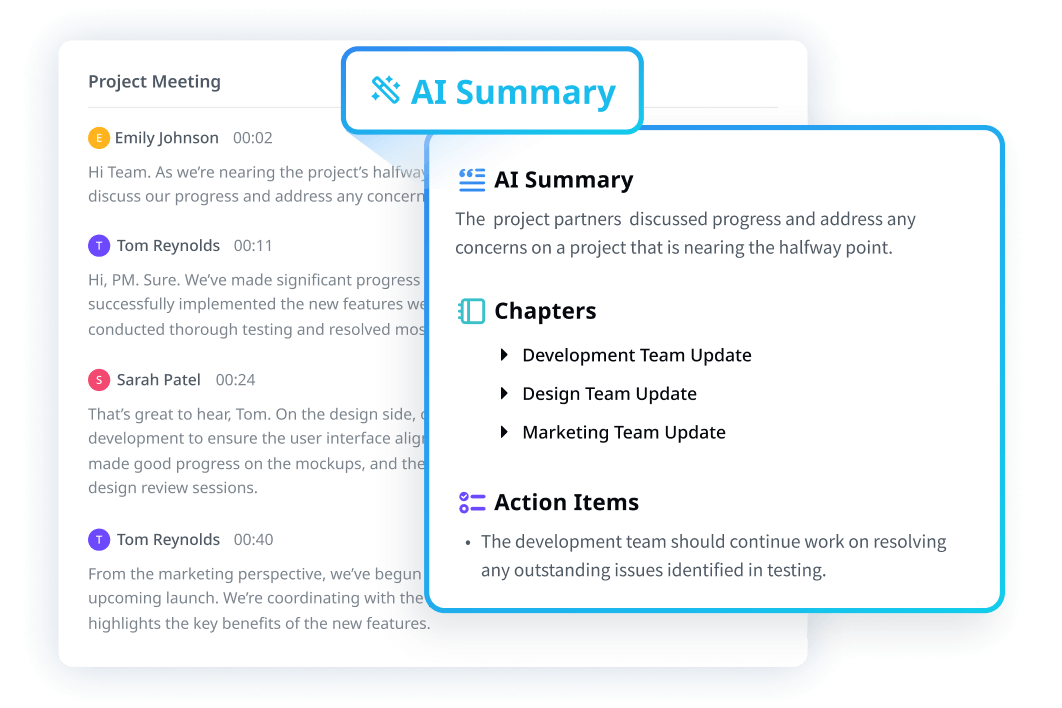
How to Run Collaborative Meetings (That Your Team Loves!)
Unlock the power of AI — Notta's meeting assistant records, transcribes and summarizes meeting minutes with one click.
Time is a precious commodity, and wasting it on unproductive meetings is unacceptable. Unfortunately, research suggests that half of all meetings may be a waste of time, especially meetings that lack preparation and collaboration.
In today's fast-paced world, a collaborative meeting is the way to success, whether brainstorming ideas, kicking off a project, or developing strategies. Such meetings allow individuals to share their ideas, provide feedback, and work together towards a shared goal, thus boosting productivity in the workplace.
But what is the secret to running a collaborative meeting? How can you ensure your team is engaged, motivated, and excited to participate in every discussion?
Join us as we identify the strategies and tools to help your team work together more effectively in this post.
What is a collaborative meeting?
A collaborative meeting is an interactive discussion through which participants work together to achieve a common goal. It usually involves people with different skills, roles, and responsibilities to generate fresh ideas.

In a collaborative meeting, all attendees have an equal opportunity to contribute and are encouraged to share their thoughts and opinions. Some examples include:
Brainstorming sessions
Problem-solving meetings
Design thinking workshops
Cross-functional team meetings
Strategy planning sessions
Project kick-offs
The benefits of collaborative meetings extend beyond accomplishing the task at hand. They also help in the following ways:
Enhance creativity: Collaborating with colleagues from different backgrounds and skill sets can bring fresh perspectives, leading to more innovative ideas and solutions.
Improve problem-solving: When a team works together, members can draw on each other's expertise to tackle problems and find solutions more effectively.
Increase engagement: Collaborative meetings allow all team members to participate actively, fostering a sense of inclusion and engagement.
Allow for greater accountability: Collaborative meetings encourage team members to take ownership of their responsibilities and work together to achieve shared goals.
Improve communication: By facilitating open and constructive communication, collaborative meetings can help team members understand each other better and therefore increase productivity.
Collaboration meetings that are well-planned and executed lead to successful outcomes for teams.
What are the elements of a collaborative meeting?
To run a successful collaborative meeting, you must ensure the following four elements are present.
1. Planning
Planning sets the tone and serves as the foundation of any successful meeting. It involves creating a clear agenda that outlines the meeting's objectives, topics, and timelines, which allows all participants to review the agenda and prepare their contributions.
Additionally, a well-planned collaborative meeting should clearly define the meeting roles and responsibilities of each team member to avoid any confusion during the session.
Identifying potential challenges or roadblocks, such as technical difficulties, lack of resources, or conflicting priorities, is also part of the planning process. By recognizing and addressing these challenges before the meeting, the team can work together to ensure a smooth and efficient operation.
2. Goal setting
Goal setting involves identifying and articulating specific objectives the team seeks to achieve from the collaboration.
To set practical goals in a collaborative meeting, consider the following tips:
Identify the purpose of the meeting: What do you hope to accomplish through this meeting?
Keep the goals specific and measurable: Goals should be clear and concise, with a quantifiable outcome. Avoid setting vague or overly broad goals that are difficult to track progress towards.
Assign ownership and accountability: Assigning ownership of goals and tasks to specific individuals helps ensure everyone is clear on their responsibilities and can be held accountable for achieving their objectives.
3. Communication
Imagine a silent meeting without interaction; how can we call it a collaborative meeting? Whether in person or virtual, active communication is the cornerstone of collaboration.
The facilitator should encourage dialogue and create an environment where everyone feels comfortable sharing ideas and opinions. Communication should be open, honest, and respectful in a collaborative meeting.
4. Decision
In a collaborative or cross-functional group, the team should work together to reach a consensus on the best way forward. As a leader, give everyone an equal opportunity to contribute, ensuring unbiased decisions. This fosters a sense of ownership and encourages team members to take responsibility for the outcome.
In the case of varying opinions, team members can work toward a compromise to achieve the end goal. If there is still unwavering disagreement, explore the reasons behind the opposition and maybe call for a majority vote to reach a decision.
Notta offers the most integrated AI meeting notes, summaries, and action items so nothing gets missed.
How to run effective collaborative meetings?
Holding an effective meeting is a vital skill for leaders. A well-run and productive meeting can help your team get more done in less time, while an ineffective meeting wastes everyone's time and energy.
Here are some tips on what to do before, during, and after the meeting.
Before the meeting
Running an effective collaborative meeting begins long before the actual meeting takes place. Below is some preparation work to consider before the meeting to ensure fruitful results.
1. Set a clear objective and agenda
First of all, you should make it clear why you are holding this meeting and what the intended outcome is.
Then you can start working on a meeting agenda based on the goal. The agenda covers topics to discuss, timeframes for each subject, and an action item section. When the agenda is crafted, distribute it before the meeting so everyone knows what to expect and can come prepared to contribute meaningfully.
2. Invite the right people
When inviting participants to a collaborative meeting, carefully consider who you invite. You should consider their skills, knowledge, and expertise and how they will contribute to the meeting's objectives. There are two types of participants you can invite:
Must: These individuals have a stake in the meeting's outcomes or possess the expertise necessary for achieving the meeting goal.
Optional: These individuals may have expertise or insights that could contribute to the meeting's objectives, but their absence would not prevent the session from going smoothly.
The ideal number of attendees should be around 4-7. The number allows for enough diversity of thought and expertise while still keeping the discussion focused and efficient.
3. Allow asynchronous brainstorming
Asynchronous brainstorming is a powerful tool for collaboration. While sending a meeting invitation, attach the meeting agenda and necessary pre-reading materials. Therefore the attendees can brainstorm asynchronously and save time in the meeting.
This approach allows team members to organize their thoughts at their own pace without the pressure of a formal meeting. It also enables team members to think deeply about the problem and even develop creative and out-of-the-box solutions.
Moreover, you can use the team's brainstorming notes as a kickoff point for the discussion.
4. Define roles and responsibilities
Finally, assign meeting roles and responsibilities before the meeting. Clearly define who will lead the discussion, who will take notes, who will be responsible for follow-up tasks, and who will present information. Therefore everyone knows what is expected of them and will contribute effectively to the meeting.
During the meeting
1. Set ground rules for communication
Every collaborative meeting needs to have ground rules for communication. These guidelines may comprise various aspects, such as respecting each other's opinions, avoiding interruptions, and keeping the discussion focused on the topic at hand.
Additionally, promoting a "no blame" culture where mistakes and misunderstandings are but opportunities for learning and growth can also enhance communication and collaboration.
2. Encourage participation from everyone
Collaborative meetings are all about teamwork, so make sure that everyone has an opportunity to share their ideas and opinions. Encouraging participation from everyone is essential to ensuring that the meeting is productive. Here are some tips for doing this:
Set clear expectations: At the start of the meeting, set clear expectations for everyone to participate. Let them know their input is valued and essential to the meeting's success.
Use icebreakers: Icebreakers are a great way to help everyone feel more relaxed and comfortable. They can also help to build rapport and encourage participation.
Embrace diversity: Recognize and embrace the different perspectives and backgrounds within the team. Encourage team members to bring their unique perspectives to the table and to share their experiences.
Ask open-ended questions: Open-ended questions encourage discussion and help to stimulate ideas. Avoid closed-ended questions that only require a yes or no answer.
Encourage active listening: Active listening involves giving full attention to the speaker, paraphrasing what was said, and asking questions to clarify understanding. This helps build trust and understanding among team members.
3. Use visual aids for collaboration
Visual aids can be a powerful tool for collaboration as they help clarify ideas, facilitate understanding, and ensure everyone focuses on the same goals.
Common visual aids include whiteboards, stickers, and flip charts to capture ideas and concepts during the meeting.
Visual aids also effectively track team members' ideas and take notes. They allow everyone to view the entire discussion, making building on ideas and generating new ones more manageable.
4. Take breaks as needed
Collaborative meetings can be intense and exhausting. Take breaks as needed to help everyone recharge and refocus. Consider scheduling regular break intervals to allow everyone to stretch, grab a snack, or use the restroom.
5. Assign action items to specific individuals
Assigning specific tasks to individual team members is essential to ensure that collaboration continues after the meeting. This creates accountability and fosters a sense of ownership among team members, increasing the likelihood of task completion.
To assign action items effectively, consider the following tips:
Be specific: Ensure each team member understands their task's scope and the expected deliverables.
Set deadlines: All deadlines should be reasonable and achievable. This helps to keep everyone on track and ensures that the project progresses on schedule.
Assign ownership: Task ownership builds on accountability and encourages team members to complete the task on time.
Follow-up: After the meeting, regular check-ins help keep everyone on track and ensure the project stays on schedule.
After the Meeting
Congratulations! You've successfully run a collaborative meeting that your team loves. But the work continues. To ensure productivity and follow-through, you must take action after the meeting. Here are some steps you can take.
1. Recap the meeting
After the meeting, send a summary to all attendees detailing the key points discussed, action items, and deadlines. You want everyone to be on the same page and can act accordingly to their roles.
To save you hours of time, I recommend using Notta AI meeting assistant to transcribe your conversations in real-time and then generate a summary automatically, including key points and next steps.

2. Evaluate the meeting
Take some time to evaluate how the meeting went. Consider what went well and what you can improve for next time. Continual improvement is the right step toward making your collaborative meetings effective.
3. Provide feedback
Give feedback to the team members participating in the meeting. It can be positive feedback for things that went well or constructive feedback for areas they could improve. Feedback will help team members grow and develop their collaboration skills.
4. Schedule follow-up meetings
If necessary, schedule follow-up meetings to discuss progress on action items and address any new issues. Keeping the lines of communication open ensures that everyone is working towards the same goal and that the collaboration continues beyond the initial meeting.
With Notta, you can easily generate meeting minutes, turning spoken content into written records with 98.86% accuracy.
Summary
Effective collaborative meetings are essential to the success of any project. It involves creating a shared vision, open and respectful communication, and careful planning to overcome potential obstacles.
And if you are running a remote collaboration meeting, use a tool like Notta to facilitate teamwork and track action items easily.
So go forth and collaborate your way to success with the tips listed in this post!